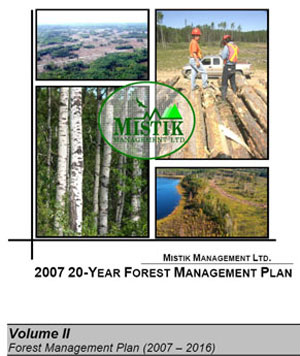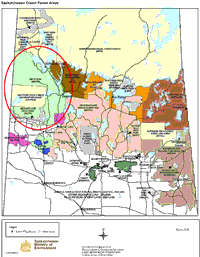Forest Management
Success Story: Integrating Climate Change into Forest Management
Mistik Management of Meadow Lake has tenure on more than 2 Million ha in the northwest portion of the province (Figure 1). Before a company is allocated any timber from the provincial forest, they must have an approved management plan that ensures the long term sustainability of the forest.
As part of its regulatory obligations Mistik Management submitted a 20 Year Forest Management Plan for provincial approval in 2007 (Figure 2). A unique feature of the plan was that it considered climate change and its implications for Sustainable Forest Management. The analyses were conducted by scientists with climate change experience from the Saskatchewan Research Council. There were three principal items of interest: forest productivity, wildfire and frozen ground conditions.
Forest Productivity
Forest productivity is the most important factor in determining how much forest is harvested in a year. In northwestern Saskatchewan, under increased CO2 scenarios, the impacts of climate change on productivity will largely be determined by moisture availability. Given adequate moisture trees are expected to significantly increase their growth rate due to CO2 fertilization. However, under drought conditions on drier soils, growth could decrease. Assuming there is increased productivity the annual rate of harvest could be increased and there may be a shorter rotation period.

Wildfire
Wildfire is expected to increase under climate change. Rather than allocate more resources to suppress fire, a more useful and cost-effective approach is to consider landscape-scale planning to reduce the risk of fire. This FireSmart approach focuses on reducing the fire hazard by harvesting and replanting with both hardwoods and softwoods in such a way that contiguous blocks of forest fuels, (e.g. large conifer stands) are broken up. This landscape-level transition in species composition would occur slowly as stands are harvested and replanted. Over several decades the fire hazard will be reduced. Also, roads could be designed to act as fuel breaks and provide ready access for fire suppression. Another adaptation to reduce fuel load is to spread slash across the total harvest areas in small pieces. This avoids large concentrations of fuel and also increases the speed of organic matter decomposition.
Frozen Ground
Generally, forest harvesting has the least impact when conducted on frozen ground. Under climate change the season of frozen ground is expected to be reduced with an earlier spring thaw and more variability in the onset of frozen ground in the autumn. Early snow cover can insulate the ground and delay freezing. Therefore the timing of snowfall and onset of freezing temperatures will be determining factors.
Adapting to these changing conditions could include the use of modified harvesting and transportation equipment (e.g. high-flotation tires or tracked vehicles) and construction of all-weather roads. Both are costly, and the latter goes against current provincial policy calling for fewer roads and immediate rehabilitation. An alternative would be to restrict winter harvest operations to drier sites only. Another possibility is to explore the use of planting and stand tending activities to manipulate water table levels.
The analyses cannot predict the future but they highlight the impacts that may be experienced under climate change, some possible adaptations and the need for on-going monitoring and adaptive management to meet the long term goal of forest sustainability.
Sources:
- Johnston, M. (2007). Impacts of Climate Change on Forest Productivity in the Mistik FMA. Prepared for Mistik Management Ltd.
- Johnston, M. (2007) The Effects of Climate Change on Frozen Ground in the Mistik FMA Area. Prepared for Mistik Management Ltd.]
- Johnston, M. and Nicolichuk, N. (2007). Assessing Future Landscape Fire Behavior Potential in the Mistik Management Forest Management Agreement Area. Prepared for Mistik Management Ltd.
- Johnston, M. and Williamson, T. (2007). A framework for assessing climate change vulnerability of the Canadian forest sector. The Forestry Chronicle, May/June 2007. Volume 83, Number 3.
- Johnston, M., Williamson, T. Munson, A., Moroni, A.O.M., Parsons, R., Price, D. and Stadt, J. (2010). Climate Change and Forest Management in Canada: Impacts, Adaptive Capacity and Adaptation Options – A state of Knowledge Report.
- Mistik Management Ltd. (2007). 20-Year Forest Management Plan. Appendix K - Key Support Documents http://www.mistik.ca/fmp.htm [accessed January 17, 2011]
- Saskatchewan Ministry of Environment. (2008) Report on Saskatchewan’s Provincial Forest. http://www.environment.gov.sk.ca/adx/aspx/adxGetMedia.aspx?DocID=aee50778-4130-42d8-8a2e-377734026b0b&MediaID=1550&Filename=Report+on+Saskatchewan+Forests.pdf [accessed January 19, 2011]
- Wheaton, E. and Wittrock, V. (2006) Future Climate and Fire Scenarios for the Forest Management Area of Mistik Management Ltd., Saskatchewan. Prepared for Mistik Management Ltd. and Saskatchewan Research Council
